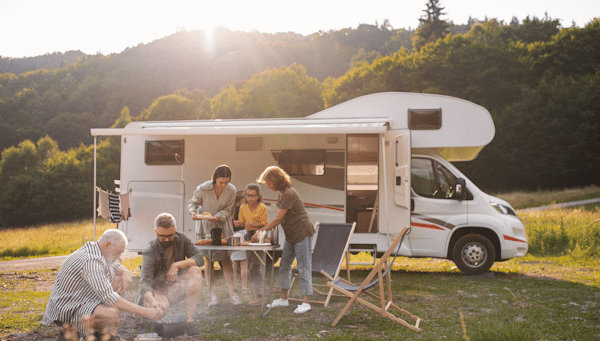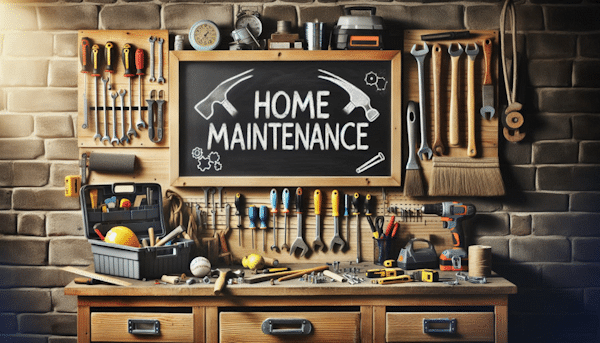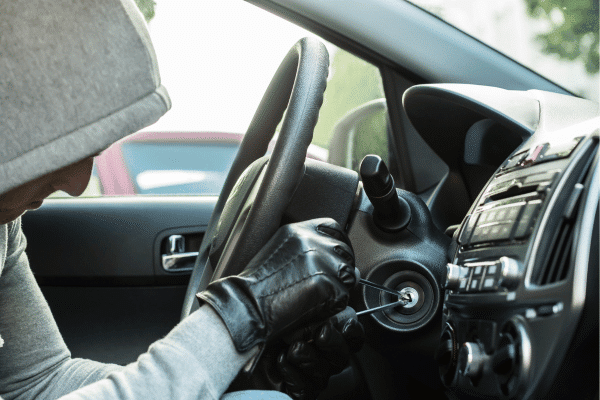
by California Casualty | Auto Insurance Info, Helpful Tips, Safety, Travel |
From traffic jams to reckless drivers, it can be stressful on the road. When you’re also juggling life’s daily demands, the stresses can leave you frazzled behind the wheel. Stressed driving not only affects your personal wellbeing, but it poses risks to road safety. Here’s how to bring back a sense of calm and control — and crush your daily commute.
How Stress Affects the Brain
Stress is the body’s reaction to potential threats. It affects your frontal lobe, where you set goals, make plans, and keep your emotions in control. It also impacts the hippocampus, which stores your memories. Importantly, stress causes a chemical reaction known as “fight or flight.” When you’re stuck in traffic or upset about being cut off, there’s often nowhere to go. That’s when your emotions can turn to road rage.
Driving While Stressed
Stress can cause mental and physical symptoms that affect not only how you feel but how you drive. Recognizing these symptoms can help you take steps to manage your stress.
Physical Signs of Stress
You may notice your heart beating faster or your palms getting sweaty. Those are common symptoms of stress. You also may feel muscle tension in your neck, shoulders and back. Biting nails, tapping fingers, and other repetitive motions also are indicators of stress. You may even get tension headaches or feel unusually tired after a short drive.
Distracted Driving
Stress often leaves you distracted. When you’re worrying about traffic, other drivers, or being late, you’re not focusing your attention fully on the road. Your concentration is reduced. You could have difficulty with decision-making and slower reaction times as a result. If you’re sitting in traffic and you pick up your cell phone to complain about the stress, that adds another level of distraction.
Irritability
When you are stressed, you may feel easily annoyed or angered by minor inconveniences. You start to engage in aggressive driving behaviors such as tailgating, speeding or frequent lane changes. This can escalate to emotions that are hard to control.
Tips to Reduce Your Stress While Driving
Stress may be unavoidable, but you can take steps that help you manage it. Follow these tips to reduce your stress behind the wheel.
- Plan ahead. Know the route you’re taking and plan your journey in advance. Be aware of alternate routes should you encounter traffic or road closures. Bringing the kids along? Pack books, snacks, and games to keep them entertained so that they do not add stress to your trip.
- Leave early. Allowing extra time for your journey can help you better handle the unexpected, such as traffic, weather, or detours. When you leave early, you are less likely to worry about being late.
- Set your playlist. Research shows that listening to music can enhance immune system function and lower levels of the stress hormone cortisol. Create a mindful playlist and avoid news or any content that might stress you out. Sing along to your favorite tunes for a mood boost.
- Adjust your posture. Improving your posture can increase oxygen flow, decrease tension in the neck and shoulders, and reduce physical discomfort. Adjust your seat and mirrors to maintain a comfortable and relaxed driving position.
- Breathe. Inhaling through your nose and into your belly is a proven way to reduce stress. Deep breathing sends a calming message to your brain, helping you relax. If you’re feeling stressed, try this breathing exercise: breathe in for a count of 8, contract one muscle group (like your neck and shoulders), then exhale and relax. Repeat for muscle groups in your neck, shoulders, and back as needed.
- Change your perspective. Managing your thoughts can help control your emotions. Instead of getting angry at a driver who cuts you off, think, “I’m glad no one got hurt.” Don’t let a stranger’s actions affect your mood.
- Pull over if needed. If stress becomes overwhelming while driving, don’t risk it. Find a safe location to pull over and take a break until you feel calmer.
- Stay fueled. Keep your car filled with gas to avoid the added stress of running low. When planning your trip, make sure you know when you plan to fuel up.
- Maintain and insure your vehicle. Make sure your vehicle is well maintained so it is less likely to break down and leave you stranded. In addition, protect your vehicle with the right insurance coverage. This will give you peace of mind for your journeys ahead. Safe travels.
This article is furnished by California Casualty, providing auto and home insurance to education professionals, law enforcement officers, firefighters, and nurses. Get a quote at 1.866.704.8614 or www.calcas.com.

by California Casualty | Helpful Tips, Safety, Travel |
You’re ready to hit the road in your RV. Whether you’re an experienced RVer or a newcomer to the lifestyle, protecting your vehicle from fire hazards can mean the difference between a dream vacation and a disaster.
As your home on wheels, your RV presents greater fire dangers than a standard vehicle. With features like kitchens and curtains, there are more opportunities for things to go up in flames. There also are electrical and mechanical components that can present a fire risk if not properly maintained. Here’s what you need to know to keep your family safe.
Electrical Systems
RVs use both AC (alternating current) and DC (direct current) power. AC operates your appliances and outlets while DC powers your engine and battery. Solar panels also are gaining popularity and can be configured to provide either AC or DC power.
- Bumps and vibrations can loosen connections. Check your electrical systems regularly to make sure connections are secure.
- Check for frayed wires and damaged outlets. Never use wires or outlets that are compromised. Replace as needed.
- If the circuit breaker shuts off power to a certain circuit, it’s probably overloaded. Other signs include lights that flicker or buzzing noises from outlets and switches. Consult a professional to ensure that you don’t have an overloaded circuit.
- While power strips are generally safe for small wattage appliances (charging cell phones or table lamps), they may not do well with high wattage. They also cannot handle continuous loads required by space heaters. Power strips can overheat and ignite combustible material in the walls.
- Don’t cover electric cords with rugs or carpets.
- Only use extension cords rated for outdoor use. If left out overnight, cords can get wet.
- If you have an electrically charged fire, don’t use water to extinguish it. Use a fire extinguisher approved for type C fires.
Propane Appliances
Propane commonly powers stoves, refrigerators and water heaters in your RV. It’s an efficient fuel that also can be dangerous if mishandled. Propane leaks can cause fires and explosions.
- Regularly inspect your propane tanks and lines for leaks or any issues. Do not use tanks and lines that have been damaged.
- Always store propane tanks in an upright position in a well-ventilated area away from a heat source.
- Turn off propane-powered appliances when not in use.
- Make sure propane-powered appliances are off when you are in motion. Gasoline vapor and an open flame are not a good combination. Also, many propane appliances need to be level and roads are not.
- Get your RV LP-certified. A licensed liquid propane technician can inspect and test your propane system.
- Consider switching to an induction cooktop and electric fridge to reduce the use of propane.
Cooking Accidents
The small space and low ceilings in most RVs make it more dangerous to cook there than at home. Most RVs use propane stove tops, which can be an added risk.
- Properly vent fuel-burning appliances. Never operate them in an enclosed space such as a bathroom, bedroom or storage area. Turn on the exhaust fan, open a window, or cook outside.
- Keep flammable materials away from the cooking area.
- Never leave cooking appliances unattended while preparing meals.
- Turn off appliances before leaving the RV.
- Check and maintain your appliances regularly. Keep them clean; make sure there are no loose or chewed wires.
- Do not use cooking appliances to heat your RV. That could create a dangerous situation where there’s insufficient oxygen in a small space.
Pro Tip: For curtains, choose natural fabrics (cotton, hemp) which are less flammable than polyester.
Engine & Mechanical
Your RV is not just a home; it’s also a vehicle. That means it’s equally important to keep the engine and mechanical systems well maintained.
- Check brakes and bearings. Improperly adjusted trailer brakes can overheat. Wheel bearings also can overheat if not properly greased.
- Make sure there are no leaks. Place a piece of cardboard under the RVs engine for a few nights to see if you have a leak. Repair any engine or transmission leak as soon as possible. Transmission fluid is highly flammable.
- Check the battery. Most RVs use lead acid batteries which must be ventilated, or they can give off dangerous gasses. Make sure the battery is open to the outside by vent or hose.
- Trailer chains that are too long can drag on the road and create sparks. Adjust them as needed. Just one spark can cause a fire.
- Improperly inflated tires can overheat and cause a fire. It also can cause the tire to fail.
- Exhaust systems can become very hot. If they have contact with flammable dry grass, it could ignite.
Safety Gear
Outfit your RV with the right safety gear so you’re alerted to any potential emergency, and you can act quickly.
- Place smoke alarms and carbon monoxide detectors in every sleeping area.
- Check the alarms and detectors, and switch batteries every spring and fall.
- Fire extinguishers should be in easy to reach areas, for example near the door. Get one that is rated type A (for wood, plastics, cloth) and type B (for liquid fuel like grease, oil, stove and motor fuel) and type C (for electric fires).
- Test your emergency exits including windows that can be used as an escape route. Make sure you have at least two ways out and nothing is blocking those paths.
If you smell gas:
- Extinguish all open flames pilot lights, lamps.
- Shut off the gas supply.
- Do not turn on an electrical switch as that can create a spark that causes an explosion.
- Remember to evacuate first. Call the fire department, and then try to put out the fire.
If you’re renting an RV:
Remember to do your due diligence to make sure your RV is safe.
- Choose a newer model. Older models of RVs have fewer and less advanced safety measures. Older engines and equipment also are more likely to fail.
- Ask the last time it was inspected.
- Look at the fire extinguisher expiration date.
- Look at the indication lights on the propane system and carbon monoxide system to see that they’re working properly.
- Check smoke alarms and carbon monoxide detectors.
- If you suspect an issue, address it before you sign the paperwork.
Finally, if you’re driving your own RV, make sure it is fully protected by insurance for your own peace of mind. Safe travels!
This article is furnished by California Casualty, providing auto and home insurance to educators, law enforcement officers, firefighters, and nurses. Get a quote at 1.866.704.8614 or www.calcas.com.

by California Casualty | Helpful Tips, Safety |
When there’s a wildfire near your home, every second counts. Leaving quickly can help you steer clear of thick smoke, dangerous conditions, and even traffic jams as everyone heads to safety. The key to a quick exit lies in preparation—having a well-thought-out plan and essential items ready to go.
Pre-Evacuation Prep
Follow this general guide to know what to pack. Keep this as a checklist and refer to it as you assemble everything that you need.
Food and Water
- Put together a 3-day supply of food for everyone in your family (unless you’re going to a relative’s or friend’s home who lives far away from the fire zone).
- Bring 3 gallons of water per person.
- Pack utensils and bowls, as you don’t know what might be available in emergency shelters.
Pet Supplies
- Pack kibble, bowls and bring water for pets.
- Bring a leash, collar, pet bed, crate or carrier, litter box, and litter as needed for your pet. Include treats and toys.
- Pack pet medications.
- Check that your pet’s microchip details are up to date.
- Bring contact information for your pet’s vet and/or your pet’s vaccine records.
Medicine and Hygiene
- Bring prescription medications and any medicines that your family may use on a regular basis: pain relievers, allergy medicines, contact lenses and solution, inhalers, etc.
- Pack hygiene items such as shampoo, soap, deodorant, toothbrushes, toothpaste, disposable razors, shaving cream, and towels.
- For infants and toddlers, bring diapers and baby wipes.
Safety
- Keep a first aid kit in your car should you need it.
- Include N95 masks if available to limit your exposure to smoke.
- Pack flashlights and batteries.
Clothing and Bedding
- Pack for practicality and safety. Layer clothes for a range of temperatures. Don’t forget PJs, socks, and underwear, as well as a raincoat or all-weather jacket.
- Comfortable, closed toed shoes work best in emergency situations.
- Bring sleeping bags, pillows and blankets. Include a portable crib for infants and toddlers.
Electronics
- Bring chargers for smartphones, laptops, and devices. Include a solar charger if you have one.
- Keep your devices well charged before you leave so you won’t have to search for a place to charge.
- Pack a battery powered radio and spare batteries in case the power goes out.
Special items
- There are some things you that you cannot replace. If you have the room, and they are easy to carry, plan to bring up to 3-5 of these special items.
- Your planning time is a good time to do a home inventory of all your possessions. Take pictures and notes of big items. This will help if your home is partially or completely destroyed by a wildfire, and you need to file a claim.
Documents
- Prepare a binder with key documents: mortgage or rental agreement, insurance policies, birth certificates, passports, bank information, and investments.
- Make sure your wallet or purse has your driver’s license, registration, health insurance cards, debit and credit cards.
- Complete a cell phone list for neighbors, family. Designate a person outside the wildfire area who can be the main contact should family members get separated or have trouble with cell service.
- Make copies of everything and keep them in a secure password protected digital space.
Prepare Your Home & Vehicle
During a wildfire, embers can travel quickly and ignite your home and property. Here are some steps to take to prepare your home and vehicle.
- Keep the vehicle that you’ll be leaving in fully gassed and well maintained. Park it in the direction it needs to go when you leave.
- Make sure that you know how to manually open the garage door in case you lose power.
- Make sure everyone in the household knows what to do to quickly evacuate.
- Close all windows. Close all interior doors.
- Take down flammable window treatments like curtains and store them out of the way.
- Turn off the gas and pilot lights. Shut off propane tanks.
- Turn off your air conditioning.
- Leave lights on to allow firefighters to see your home in the dark.
- Bring potentially flammable outside furnishings, toys and doormats inside or place them in your pool.
- Attach garden hoses to outside taps for firefighters to use. Placed filled buckets of water around your home.
- Listen to first responders and be ready to act when they recommend evacuation.
Pro Tip: California Casualty policyholders may be able to get immediate help if they are evacuated by fire. Evacuation expenses, such as hotel or other temporary housing, and meals are reimbursable with most policies.
Review your wildfire evacuation plan often. Keep it updated as your family grows and needs change. Finally, protect your home with the right insurance for added peace of mind.
This article is furnished by California Casualty, providing auto and home insurance to educators, law enforcement officers, firefighters, and nurses. Get a quote at 1.866.704.8614 or www.calcas.com.

by California Casualty | Helpful Tips |
It’s easy to get caught up in summer fun. But it’s important not to overlook home maintenance. Taking care of your home during the summer months can prevent costly repairs down the road and help avoid unwelcome surprises. So, while you’re planning your beach trips and barbecues, don’t forget to give your home some much-needed TLC.
Interior Maintenance
- Air Conditioning:
- Look at your outdoor unit and clean away any debris. Replace the air filters. A clogged filter can cause your system to shut down. Have a professional check that the condensate drain is clear, the condenser coils are clean, and that the coolant lines are insulated. If you choose to do work on your air conditioner yourself, make sure to shut off the circuit breaker first.
- Attic and Basement:
- Check for signs of mold and mildew, leaks, holes in the roof, and pests. Mold often looks dark green or black on the surface of wood and other materials. Water damage can appear as peeling paint or discoloration. You also may notice a musty smell. Take action to correct any of these issues.
- Ceiling Fans:
- Check that your fans are working properly. If your fan allows you to change its direction, switch it so it runs counterclockwise in the summer months. This will help push cooler air down and allow you to keep your home at a slightly higher temperature while still feeling comfortable. This will save energy. Not sure if your fan changes direction? Look for a switch in the fan’s motor or on the box underneath the fan.
- Chimney:
- The perfect time to clean your chimney is when you are not using it. You will want to remove the highly flammable creosote buildup that is caused by burning wood. Hire a professional. If you prefer to DIY the cleanup, get your chimney inspected by a qualified chimney sweep. They are trained to recognize chimney deterioration and venting problems.
- Dryer:
- Lint and debris in your dryer vent and exhaust duct can be a fire hazard. If it’s taking longer than usual for your clothes to dry, that probably means your duct and vent needs to be cleaned. It’s a simple do-it-yourself process.
- Garage:
- Check your garage for hazardous materials, like paints, cleaning supplies, and lawn chemicals. When combined with summer heat, some of these items could become dangerous. Arrange for a safe place to store them where the temperature is more moderate.
- Smoke Detectors:
- Water Fixtures:
- Check for leaks from your water faucets, plumbing and pipes. This is wasted water that can result in higher water bills. Pro tip: Install a leak detection device.
- Windows and Doors:
- Patch holes in window screens or replace mesh if there is a lot of damage. Clean windows inside and out, using a foam paintbrush for the tracks.
- Check the seals on windows and doors. If you see daylight around the door or window frame, there’s an air leak. Seal it with caulk as needed.
Exterior Maintenance
- Decks and Patios:
- Look for loose boards, screws or nails on your deck. Clean and reseal wood decks to prevent rotting and protect it from UV rays. Check for loose tiles or broken cement on your patio and make those repairs. Clean patio furniture.
- Fence:
- Look for any problem areas in your fence that makes it less secure. Check the upright supporting posts for wear and tear. Fill in any holes under the fence. Repair chipped paint and clean dirty or stained spots.
- Foundation:
- Summer heat can cause the soil under your home to shrink. This can create gaps and cause your foundation to settle. Keep your eye out for exterior foundation cracks. You also may notice interior wall cracks or slanted floors. Acting sooner rather than later will help minimize damage.
- Grill:
- Your grill is your outdoor kitchen during the summertime. Make sure it is clean and in good working order. Check for rust, cracks and any parts that may need repair. For gas grills, examine the gas lines and connections for leaks. Use a stiff brush to clean away food particles and grease that could cause dangerous flare-ups. Cover your grill when not in use to keep pests and animals from nesting there.
- Gutters:
- If water doesn’t flow through your gutters, it can build up and damage your roof. Inspect your gutters and clean out the debris. Don’t forget to clean the drains and downspouts too.
- Lawn Maintenance:
- Keep your mowed grass on a taller setting so the blades will help shade the soil. This will help reduce water evaporation. Use a water calculator to give your lawn the ideal amount for your region.
- Play Equipment:
- Make sure swing sets and other play equipment are still sturdy and safe for use. Repair or replace any that could be dangerous.
- Pool:
- Vacuum your swimming pool to remove dirt and debris. Clean your pool’s filter. Keep an eye on the water chemistry. Pro tip: Toss in a tennis ball. The wool and nylon help to absorb oils like sunscreen that are in the water.
- Roof:
- Get up on your roof to see if there are any damaged or missing shingles, signs of leaks, and problems with flashing. Repair and replace as needed.
- Siding:
- Look for loose or damaged siding, and signs of rot. Repair or replace as needed. You can pressure wash siding to remove built-up debris.
- Sprinkler Systems:
- Test your sprinkler system and outdoor faucets and look for leaks. These are also places for wasted water that could increase your bill.
- Trees:
- Trim your tree branches so you don’t give squirrels a highway to your house. Branches should be at least 8 feet from your roof.
- Walkways and Driveways:
- Inspect and patch any cracks with flexible sealant. Pressure wash walkways and driveways to remove dirt and stains.
Finally, protect your home with the right insurance for peace of mind. Enjoy your summer!
This article is furnished by California Casualty, providing auto and home insurance to educators, law enforcement officers, firefighters, and nurses. Get a quote at 1.866.704.8614 or www.calcas.com.

by California Casualty | Auto Insurance Info, Calcas Connection, Good to Know, Helpful Tips |
You’re ready to head home after a night out, but there’s one thing missing: your car. You could have sworn you parked it right here, but it’s no longer there. Vehicle theft can happen anytime, anywhere. When it comes to keeping your car safe, where you park can make all the difference.
Theft by the Numbers
A vehicle is stolen every 32 seconds, according to the National Insurance Crime Bureau. More than a million vehicles are reported stolen each year. California and Colorado have some of the highest number of auto thefts in the country, and of course, urban centers are hotspots for theft. However, thefts happen in the suburbs too, and cars can even be taken from your driveway. In honor of July, National Vehicle Theft Protection Month, we’re taking a look at what you need to know to keep your vehicle safe.
The Worst Places to Park Your Car
Thieves are looking for a chance to steal a car. Don’t give them the opportunity to steal yours. Before you park your car for a short time, or overnight, look around and assess the area for theft potential. Is the area well lit? Are other vehicles parked nearby? Are people around? Is there a security camera or guard? Are there signs of break-ins or damage? All of these can offer clues to an area’s safety.
Avoid empty streets.
Quiet streets and alleyways offer thieves a place to work without interruption. With no one around to witness the theft, they can get in and out quickly with your vehicle.
Avoid poorly lit areas.
Thieves prefer locations where they can work without being seen. Well-lit areas increase their chances of being noticed, while poorly lit and dark locations offer cover.
Avoid high-crime areas.
Do your research before parking in a new place. If the crime rate is high, it’s worth paying for a more secure parking option. High-crime areas aren’t just seedy sections of town. They could be residential neighborhoods that are targeted by thieves.
Avoid empty lots.
You may see lots of cars at office parking lots or at schools. However, when these buildings are not in session, the empty lots provide an easy place for thieves to work. Don’t be tempted to park in an empty lot and put your vehicle at risk.
Avoid remote locations.
Places that are less frequently traveled can be attractive for thieves. Chances are these locations are less often patrolled.
Avoid parking near large vehicles.
Parking your smaller car next to a larger vehicle automatically gives thieves cover. The truck or large car blocks the view so they can work without being easily seen.
How to Protect Your Vehicle
A skilled thief can steal a car in about a minute. However, there are things you can do to make your car seem harder to steal because it will take longer, or they are more likely to get caught.
When parking away from home:
- Park in a garage with security cameras. Park in view of the cameras.
- Be aware of tow truck thieves who come in and tow away your vehicle. When you park, turn your wheel as far to one side as possible. If you have front-wheel drive, park forwards in the spot. For rear wheel drive, back into the spot. This will make it harder to tow your car.
- If you’re parking on the street, choose a busy road where there will be people and other cars the whole time your car will be there.
- Lock your vehicle. The first thing that thieves do is try the doors.
- Hide your valuables out of sight. Even loose change, phone chargers, and other items can tempt thieves to break in.
- Don’t crack your window open on a hot day. An experienced thief can use that to get inside.
- Protect your catalytic converter by etching your VIN onto it.
- Don’t run your car with the keys in it – while you’re somewhere else.
- Keep your registration and insurance in your wallet rather than your glove compartment. That will help prevent the risk of identity theft if your car is stolen.
- Use an anti-theft system. New cars come with one, and you can also add one after market.
When parking at home:
- If you can, park inside your home’s garage. Don’t leave the garage door open. Out of sight is out of mind, and thieves won’t try to steal a car they cannot see.
- Add motion sensor lights to your home and driveway area.
- Don’t leave your key fob in the car. Don’t put it near a door or window inside your home either. Thieves can use the signal to break into your vehicle. Consider keeping keys in a container that doesn’t allow digital signals to pass through.
If your car is stolen, be aware of resources for auto theft victims. Your vehicle is one of your greatest investments. Protect it with the right insurance.
This article is furnished by California Casualty, providing auto and home insurance to educators, law enforcement officers, firefighters, and nurses. Get a quote at 1.866.704.8614 or www.calcas.com.





